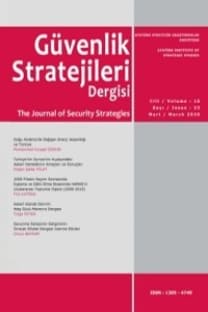NATO’nun Savunma ve Caydırıcılık Çalışmaları ile İlgili Bir Değerlendirme
Savunma, caydırıcılık, istikrarsızlık, güvenlik, ittifak, NATO
An Assessment on NATO’s Defence and Deterrence Studies
Defence, Deterrence, Instability, Security, Alliance, NATO,
___
- Kitaplar Alexander L. George ve Richard Smoke, Deterrence in American Foreign Policy: Theory and Practice, Columbia University Press, New York 1974.
- Andrew R. Morral ve Brian A. Jackson, “Understanding the Role of Deterrence in Counterterrorism Security”, Santa Monica: RAND Corporation, 2009.
- Anthony H. Cordesman, “NATO and the Delicate Balance of Deterrence: Strategy versus Burden Sharing”, CSIC Center for Startegic&International Studies, Şubat 2017.
- Glen H. Snyder, Deterrence and Defense: Toward a Theory of National Security, Princeton University Press London, 1961. John J Mearsheimer, Conventional Deterrence, Cornell University Press, New York 1983.
- Lawrence Freedman, Deterrence, Cambridge Polity Press, 2004.
- Paul K. Huth, Extended Deterrence and the Prevention of War, Yale University Press,1988.
- Sten Rynning, “Deterrence Rediscovered: NATO and Russia”, Frans Osinga ve Tim Sweijs, (ed.), Deterrence in the 21st Century; Insights from Theory and Practice, Asser Press by Springer-Verlag Berlin Heidelberg, 2020, 29-47.
- Thomas Schelling, Arms and Influence, Yale University Press, New Haven 1966
- Trine Flockhart vd, Liberal Order in a Post-Western World, Transatlantic Academy, Washington DC., Mayıs 2014.
- Makaleler Benjamin Schreer, “Trump, NATO and he Future of Europe’s Defence”, The RUSI Journal 164.
- Dmitry Adamsky, “From Moscow With Coercion: Russian Deterrence Theory and Strategic Culture”, Journal of Strategic Studies 41, 2018.
- Frans-Paul van der Putten, vd., “Deterrence as a Security Concept Against Non-Traditional Threats”, Netherlands Institute of International Relations In-depth study Clingendael Monitor June 2015.
- Jeffrey Knopf, “The Fourth Wave in Deterrence Research”, Contemporary Security Policy 31 (2010) 1.
- John J. Mearsheimer, “Why the Ukraine Crises is the West’s Fault: The Liberal Delusion that Provoked Putin”, Foreign Affairs, 93(5).
- Łukasz ve Kulesa Thomas Frear, Deterrence NATO’s Evolving Modern Deterrence Posture: Challenges and Risks, European Leadership Network (ELN) Issue Brief, Mayıs 2017.
- Nina Slove, “Beyond the Buzzword: The Thre Meanings of Grand Strategy”, Security Studies 27, 2018.
- Stephen Brooks ve William C. Wohlforth, “The Rise and Fall of the Great Powers in the Twenty-first Century: China’s Rise and the Fate of America’s Global Position”, International Security 40:3, 2015/16.
- Steven Keil, Heinrich Brauß, ve Elisabeth Braw W, “Next Steps in NATO Deterrence and Resilience”, The German Marshall Fund of the United States Policy Paper, Haziran 2021.
- Tom Rostoks ve Nora Vanaga, “Deterring Russia in the Baltic Sea Region: Latvia’s Defence Developments in Regional Context”, Friedrich Ebert Shiftung FES Analysis, 2017,
- İnternet Kaynakları Frantzen A. Henning, “Hybrid Deterrence”, Norwegian Institute for Defence Studies (2020), s. 1, https://www.jstor.org/stable/resrep25796, (Erişim tarihi: 12.10.2021)
- Jen Judson, https://www.defensenews.com/digital-show-dailies/ausa/2019/10/11/fighting-the-bureaucracy-for-nato-the-defender-2020-exercise-in-europe-will-test-interoperability/, (Erişim tarihi: 06.10.2021)
- NATO 2014 Galler Zirvesi Deklarasyonu, http://www.nato.int/cps/en/naohq/official_texts_112964.htm, (Erişim tarihi: 04.10.2021)
- NATO Genel Sekreterinin konuşması, https://www.nato.int/cps/en/natohq/opinions_176197.htm, (Erişim tarihi 28.09.2021)
- NATO 2019 Londra Deklarasyonu, http://www.nato.int/cps/en/naohq/official_texts_171584.htm, (Erişim tarihi: 01.10.2021)
- NATO 2030; United for a New Era, https://www.nato.int/nato_static_fl2014/assets/pdf/2020/12/pdf/201201-Reflection-Group-Final-Report-Uni.pdf, (Erişim tarihi 28.09.2021)
- NATO web sayfası, https://www.nato.int/cps/en/natohq/topics_133127.htm, (Erişim tarihi: 17.10.2021)
- NATO Belgeleri NATO Public Diplomacy Division, NATO Summit Guide, Varşova, 8-9 Temmuz 2016.
- NATO Public Diplomacy Division, NATO Summit Guide, Brussels, 11-12 Temmuz 2018.
- ISSN: 1305-4740
- Yayın Aralığı: 3
- Başlangıç: 2005
- Yayıncı: Millî Savunma Üniversitesi Atatürk Stratejik Araştırmalar ve Lisansüstü Eğitim Enstitüsü
NATO’nun Savunma ve Caydırıcılık Çalışmaları ile İlgili Bir Değerlendirme
Sivil Bireylerin Terörizm Korkusuna Nitel Perspektiften Bakış
Begüm ÇARDAK, Mustafa Sıtkı BİLGİN
Harp Ceridesine Göre 16’ncı Tümen’in Çanakkale Cephesi’nin Tahliyesi Sürecindeki Faaliyetleri
Büyük Stratejilerde Örüntü: Türkiye-Rusya İlişkilerinde Akıllı Uyum ve Esnek Rekabet
Alperen Kürşad ZENGİN, İlyas TOPSAKAL
Osmanlı Donanması’ndaki Yerli İmkânlarla Bir Muharebe Gemisi İnşa Deneyimi: Abdülkadir
